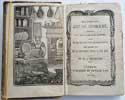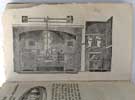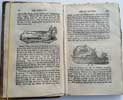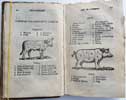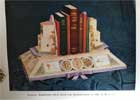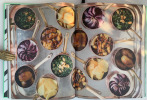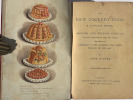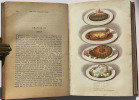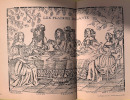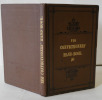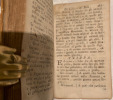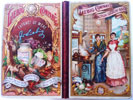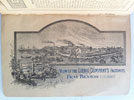COOKERY MADE EASY;
BEING A COMPLETE SYSTEM OF DOMESTIC MANAGEMENT, UNITING Elegance with Economy. TO WHICH IS ADED, INSTRUCTIONS FOR TRUSSING AND CARVING, WITH SEVERAL DESCRIPTIVE PLATES; MOTHOD OF CURING AND DRYING HAAMS AND TONGUES; MUSHROOMS AND WALNUT KETCHUPS, QUIN’S SAUCE, VINEGARS, &c. &c. With other necessary Information FOR SMALL FAMILIES, HOUSEKEEPERS, &c. THE WHOLE Being the Result of actual Experience. By MICHAEL WILLIS, MANY YEARS COOK AT THE THATCHED-HOUSE TAVERN. LONDON: PRINTED BY W. LEWIS, 21, FINCH LANE; FOR JOHN BUMPUS, HOLBURN BARS; AND BE HAD OF ALL BOOKSELLERS. 1824
FIRST EDITION. 164 X 100mm. 1fep. [1] Unusual Frontispiece of two meat suppliers. Title page. [1] (1)iv-vi Preface. (1)viii-xvi Contents. 5p Plates of Trussing and Carving. (1)2-205. 206-213 Bills of Fare. p214-216 Marketing Tables. 2feps. Frontis evenly foxed. Some age browning and light sporadic foxing throughout. Original slightly faded grey cloth covers with a dark leather and gilt label on spine.
- At Willis's place of employment during the London season on Sunday evenings, the Thatched House Tavern on St. James St. hosted the dinners of the Dilettanti Society. Portraits of the members, many of them painted by Sir Joshua Reynolds, adorned the walls of a room devoted exclusively to their use. The society met originally at Parsloe's in St. James's St., but moved to the Thatched House Tavern in 1799. Many other art societies and associations, as well as the Royal Navy club used the large and elegant rooms of the Tavern. St. James Street dates to 1670 and runs northward from St James Palace. The poets Waller and Pope lived there, Wren till he died in 1723, Gibbon the historian till 1794 and Lord Byron lodged at #8, in 1811. The tavern was also the favourite haunt of Swift. At the south-west end of the street next to the Palace was the St James Coffee Hse, but taken down in 1806. From early times the street found favour with the London literary scene, which in turn was favourable to the growth of well appointed taverns and clubs. The Thatched House was pulled down in 1863. It was nearly the last remaining relic of old St James St. On part of its site the Civil Service club was erected. Michael Willis the cook and author, appears to be a very confident man, especially about his book. In the last lines of the preface he proclaims: “The object of the writer has been to furnish a valuable and useful book at a low price; and the approbation of the public is his highest ambition. It contains twice as much as any similar works hitherto published at Four Pounds the Price! and he has no hesitation in asserting, that it is surpassed by none, either in quantity, quality, or variety”. It is a interesting book with some nice detail in the recipes, as expected of a professional cook. Also interesting as a culinary record of a famous and high class Tavern. The book has been produced in a modern facsimile, so it has had a modern impact that could never have been foreseen nor dreamed of by Willis two centuries ago.

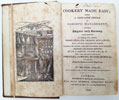
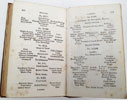



click on image to enlarge

Antiquarian category
ref number:
11207 
